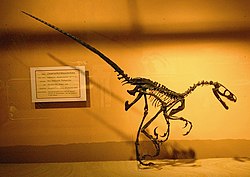Top Qs
Timeline
Chat
Perspective
Kirtland Formation
Geological formation in New Mexico and Colorado, United States From Wikipedia, the free encyclopedia
Remove ads
The Kirtland Formation (originally the Kirtland Shale) is a sedimentary geological formation.[1]

Remove ads
Description
Summarize
Perspective
The Kirtland Formation is the product of alluvial muds and overbank sand deposits from the many channels draining the coastal plain that existed on the inland seashore of North America, in the late Cretaceous period. It overlies the Fruitland Formation. It is found in the San Juan Basin in the states of New Mexico and Colorado, in the United States of America.
The base of the Kirtland Formation and its lowest sub-unit, the Hunter Wash member, has been dated to 75.02 ± 0.13 Ma.[2] Together with the upper part of the underlying Fruitland Formation, this contains fossils representing the Hunter Wash local fauna. The border between the Hunter Wash member and overlying Farmington member dates to approximately 74 million years ago. The top of the Farmington member and bottom of the overlying De-na-zin member has been radiometrically dated to 73.83 ± 0.18 Ma ago. The top of the De-na-zin member, which contains the Willow Wash local fauna, has been dated to 73.49 ± 0.25 Ma ago.[1]
Overlying the De-na-zin member is a unit called the Naashoibito member This has often been considered to be part of the Kirtland formation, but more recently has been transferred back to the overlying Ojo Alamo Formation, which it had originally been part of.[1]
Remove ads
History of investigation
The formation was named by C.M. Bauer in 1916 for exposures near the Kirtland Post Office.[3]
Stratigraphy

Vertebrate paleofauna
Summarize
Perspective
Saurischians
Ornithischians
Pterosaurs
Crurotarsans
Turtles
Bony fish
Cartilaginous fish
Color key
|
Notes Uncertain or tentative taxa are in small text; |
Remove ads
See also
References
Wikiwand - on
Seamless Wikipedia browsing. On steroids.
Remove ads



















